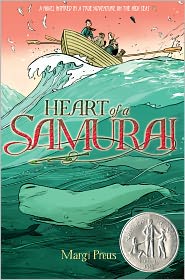Note: this review was originally published on February 4, 2011.
Heart of a Samurai, by Margi Preus, Amulet Books, 277 pages plus historical note and glossary.
Reading Level: Middle Grades, ages 10-12
Maturity Level: 4 (ages 10 and up)
Bottom line: This Newbery-winning fictionalized biography for middle graders is as likeable as its hero, with multicultural value and beautiful illustrations.
 This is the true story of Manjiro, a young Japanese fisherman, who with five companions was shipwrecked on “Bird Island” (a rock covered with albatross and gulls) in the northern Pacific, 1841. They are dying of starvation when American sailors on the John Howard, a whaler out of New England, sight and rescue them. Captain John Whitfield transports the boys to Hawaii but Manjiro, an unusually curious and adventurous youth, chooses to sign on for the rest of the voyage. The Captain comes to regard the boy as a son while they spend hours together at the bulwark of the John Howard, talking into the night, their words given to the darkness for safekeeping. These strange Americans stir Manjiro’s imagination–he longs to see America for himself: He had found a new way of seeing the world. Not with fear, but with wonder.
This is the true story of Manjiro, a young Japanese fisherman, who with five companions was shipwrecked on “Bird Island” (a rock covered with albatross and gulls) in the northern Pacific, 1841. They are dying of starvation when American sailors on the John Howard, a whaler out of New England, sight and rescue them. Captain John Whitfield transports the boys to Hawaii but Manjiro, an unusually curious and adventurous youth, chooses to sign on for the rest of the voyage. The Captain comes to regard the boy as a son while they spend hours together at the bulwark of the John Howard, talking into the night, their words given to the darkness for safekeeping. These strange Americans stir Manjiro’s imagination–he longs to see America for himself: He had found a new way of seeing the world. Not with fear, but with wonder.
Since Heart of a Samurai is a novelized biography, the action is linear and episodic but unified around the multicultural theme of a stranger in a strange land. Its pages reveal such an appealing character (as Manjiro evidently was in real life), that the reader wants to share his discoveries. He finds Americans to be good-hearted, generous and . . . He didn’t have a name for it, but it seemed natural, like second nature, for them to be kind to others while expecting nothing in return. Americans have their unfriendly, pushy, bigoted representatives, and Manjiro experiences that as well. But when he eventually returns home and is imprisoned by his own people for “spying,” he protests: “America is strong, yes. It has many weapons. But it isn’t angry! America doesn’t want to attack Japan!” Manjiro went on to high honor in his homeland, receiving a second name and becoming an adviser to the Emperor and a liaison between Imperial Japan and the United States. His story is encouraging and uplifting, a window both to the past and to another culture. And the book is physically beautiful: Manjiro was a gifted artist and some of the drawings that illustrate his story are his own. Ocean and whaling motifs decorates the book throughout, reflecting the delicate characteristics of Japanese painting.
Also by this author: Shadow on the Mountain
Cautions: None
Overall Value: 5 (out of 5)
- Worldview/Moral value: 4.5
- Artistic Value: 5
Categories: Discussion Starter*, Starred Review, Auto/Biography, History, nonfiction, Award Winners
*Discussion Questions:
- Literary element: This type of book is known as “fictionalized” nonfiction. Where do you think the fiction comes in?
- Thematic element: Manjiro’s attitude toward his American rescuers is very different from his fellow fishermen. How was it different, and what qualities of character contributed to his attitude?
- Worldview element: Manjiro converted to Christianity while living in New England. Do you think he really became a Christian? Why or why not?
Stay Up to Date!
Get the information you need to make wise choices about books for your children and teens.
Our weekly newsletter includes our latest reviews, related links from around the web, a featured book list, book trivia, and more. We never sell your information. You may unsubscribe at any time.
Support our writers and help keep Redeemed Reader ad-free by joining the Redeemed Reader Fellowship.
Stay Up to Date!
Get the information you need to make wise choices about books for your children and teens.
Our weekly newsletter includes our latest reviews, related links from around the web, a featured book list, book trivia, and more. We never sell your information. You may unsubscribe at any time.
We'd love to hear from you!
Our comments are now limited to our members (both Silver and Golden Key). Members, you just need to log in with your normal log-in credentials!
Not a member yet? You can join the Silver Key ($2.99/month) for a free 2-week trial. Cancel at any time. Find out more about membership here.
2 Comments
Leave a Comment
You must be logged in to post a comment.

I have the book by Rhoda Blumberg “Shipwrecked” that tells the same story. I purchased it as part our reading of “Two Years Before the Mast”. While “Shipwrecked” is written as a children’s book, I am wondering if you have also seen it and can compare the two. I’d like “Shipwrecked” or “Heart of a Samurai” to be added to our history class literature choices on immigration/emigration experiences in America.
Marion,
I haven’t heard of Shipwrecked. My only exposure to Manjiro’s story was the American Heritage article cited in the review. I’m not surprised that there are earlier (I presume much earlier) treatments of such a great story. I can definitely recommend Heart of a Samauri for classroom study, though. (ps. I’m a big fan of Two Years Before the Mast.)